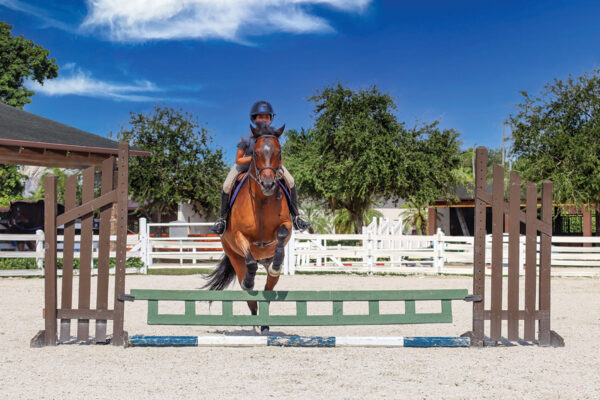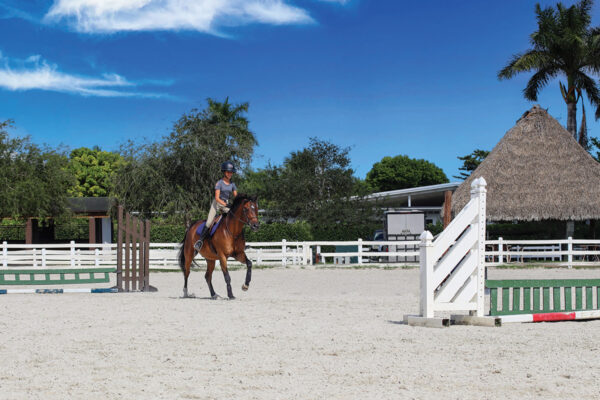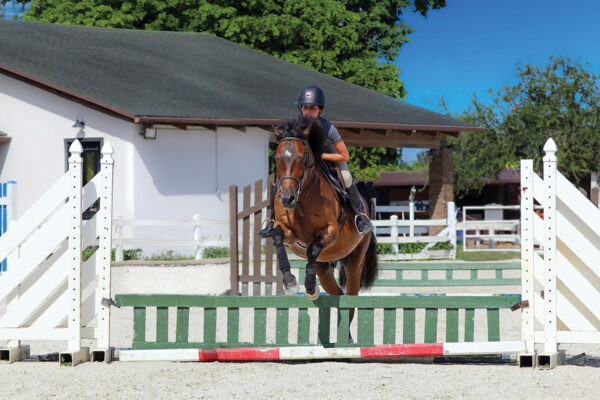
If you love to jump, eventually the time will come that you start to ride longer courses, jump bigger jumps, and maybe even show. At this point, it becomes more and more important that you are able to count your strides in a line of jumps.
This will help you become a better rider because you will know when to send your horse forward, when to half-halt, and when it’s time to get into your two-point to follow your horse’s jumping effort and give him the release he needs in his mouth and over his back.
Whether you’re riding at home or at a show, lines of jumps are measured according to your horse or pony’s length of stride. When you’re getting the correct number of strides in the lines, you know that you’re riding the correct rhythm you need to be successful. It’s like having checkpoints all around the arena to help you!
Counting Strides on the Flat
The first step to counting strides is to be sure you know exactly what you are counting. A great way to practice is to start while you are flatting.
Count how many steps your horse does from one point in the arena to another. This could be from fence post to fence post, between sets of jump standards, or down an entire side of the arena. Watching your horse’s inside shoulder to see when it stretches forward can help you mark each stride while you are figuring out the rhythm.
You could also take turns with a friend, with one of you helping count from the ground and one of you riding, and then switch—it’s super helpful to see things from both viewpoints.
Counting Between Jumps
Once you are comfortable with feeling your horse’s stride and counting it, then you can move on to counting how many strides are in a line of jumps. It’s a great idea to practice over poles, especially if you’re not allowed to jump outside of lessons, but sometimes the use of a small jump can make it easier to feel the landing step versus the first stride.
This is probably the most common mistake when people are starting to learn how to count strides: They will count the landing step as “one,” and then their count is wrong for the rest of the line.
Instead, when your horse’s front legs hit the ground after a jump or canter pole, say or think “land.” Once his hind legs come off of the jump and touch down, they begin to push forward, and that is the beginning of the stride numbered “one.”

Feeling this can take some practice, especially when you are focused on lots of other things, such as your takeoff spot to the first jump and your position in the air.
From there, it’s easy to count your strides until takeoff at the second jump in the line. The more complicated part is getting used to knowing where you are within the line: whether you are getting to the second jump just right or on the half-stride, which results in a chip or a long spot.
Judging Your Strides
This is another thing that takes practice, as well as awareness of your horse’s natural rhythm. If your mount is naturally quick and covers the ground easily, you will likely need to be feeling the reins and half-halting to keep him steady in the line.
If he tends to be quieter or have a shorter stride, you will need to land and then start adding leg at stride one in order to keep the pace rolling and get the correct number of strides rather than, for example, six and a half or seven in a six-stride line.

There are other factors that may affect how a line rides for you as well, such as whether the line rides toward the gate or away (most horses get quicker going toward the gate); whether the line is at the beginning of the course or the end (momentum naturally builds throughout the course); and how your distance was when you jumped into the line. A long spot jumping in may need a half-halt where you weren’t expecting to need one, or a chip in will need you to squeeze and add leg even on a hotter horse.
A good tool for deciding how to ride each line is putting something, such as a cone, at the midpoint of the line. This will help you recognize that, for example, in a six-stride line you should be completing stride number three as you pass your marker. If you’ve only done two, you need to slow down, and if you’ve already done four, you need to speed up!
This is what makes counting strides tricky, because every situation can be just a little bit different. You’ll need to rely on your prior experience to know what choices to make. Lots of good practice is the only way to get the experience that will keep you cantering and counting smoothly through your lines.
In this masterclass video from Ridely, Olympic medalist Meredith Michaels-Beerbaum explains that the strides are important because they give you an idea of your pace in the course. Meredith’s daughter, Brianne Beerbaum, demonstrates the exercise Meredith uses with young riders. Register for Ridely PRO to access 450+ other useful training videos.
This article about counting strides appeared in the January/February 2023 issue of Young Rider magazine. Click here to subscribe!


